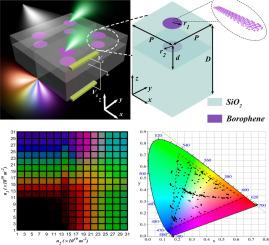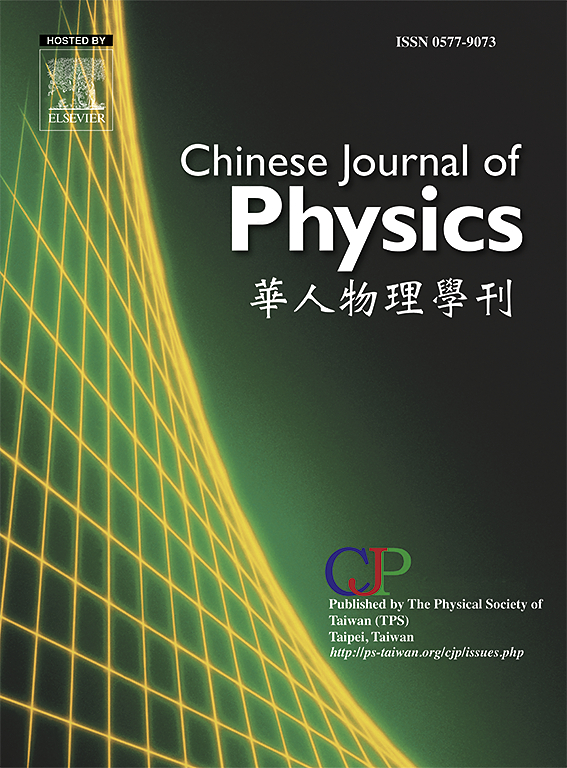Carrier density tunability and encryption in plasmonic structural colors via dual-layer borophene nanodisk metasurfaces
IF 4.6
2区 物理与天体物理
Q1 PHYSICS, MULTIDISCIPLINARY
引用次数: 0
Abstract
Structural colors are different from pigment colors. They are dominated by optical waves and micro- and nanostructures. In this work, we present a metasurface structure color device based on dual-layer borophene nanodisks (BN). By just tuning the bias voltage without changing the geometric parameters, the spectral profile can be customized. Thus, the metasurface can present specific colors. Through numerical analysis using Finite Difference Time Domain (FDTD) theory, we investigate the printed color property of the system, which achieves an ultra-high resolution of up to 106 dots per inch () and covers 121 of the color gamut area within fixed structural parameters. In addition, as the direction of polarization switches, the system can display two color states: encrypted and non-encrypted. The metasurface also demonstrates robust performance across various incident angles. Moreover, it is capable of distinguishing between normal and basal cancer cell solutions by analyzing their color differences. These findings highlight potential applications in information encryption, polarization imaging, color sensing, and cancer detection. Besides, the research gap in the field of structural colors featuring encryption capabilities, high resolution, tunable carrier density, geometric stability, and broad color gamut coverage has been filled.

双层硼罗芬纳米盘超表面等离子体结构色的载流子密度可调性和加密
结构色不同于颜料色。它们以光波和微纳米结构为主。在这项工作中,我们提出了一种基于双层硼罗芬纳米片(BN)的超表面结构彩色器件。通过调整偏置电压而不改变几何参数,可以定制光谱轮廓。因此,超表面可以呈现特定的颜色。利用时域有限差分(FDTD)理论进行数值分析,研究了该系统的印刷色彩特性,该系统在固定结构参数下实现了高达106点/英寸(dpi)的超高分辨率,覆盖了sRGB色域面积的121%。另外,作为偏振方向开关,系统可以显示加密和非加密两种颜色状态。该超表面在各种入射角上也表现出强大的性能。此外,它能够通过分析正常和基础癌细胞溶液的颜色差异来区分它们。这些发现突出了在信息加密、偏振成像、颜色感应和癌症检测方面的潜在应用。填补了具有加密能力、高分辨率、载流子密度可调、几何稳定性、广色域覆盖等特点的结构色领域的研究空白。
本文章由计算机程序翻译,如有差异,请以英文原文为准。
求助全文
约1分钟内获得全文
求助全文
来源期刊

Chinese Journal of Physics
物理-物理:综合
CiteScore
8.50
自引率
10.00%
发文量
361
审稿时长
44 days
期刊介绍:
The Chinese Journal of Physics publishes important advances in various branches in physics, including statistical and biophysical physics, condensed matter physics, atomic/molecular physics, optics, particle physics and nuclear physics.
The editors welcome manuscripts on:
-General Physics: Statistical and Quantum Mechanics, etc.-
Gravitation and Astrophysics-
Elementary Particles and Fields-
Nuclear Physics-
Atomic, Molecular, and Optical Physics-
Quantum Information and Quantum Computation-
Fluid Dynamics, Nonlinear Dynamics, Chaos, and Complex Networks-
Plasma and Beam Physics-
Condensed Matter: Structure, etc.-
Condensed Matter: Electronic Properties, etc.-
Polymer, Soft Matter, Biological, and Interdisciplinary Physics.
CJP publishes regular research papers, feature articles and review papers.
 求助内容:
求助内容: 应助结果提醒方式:
应助结果提醒方式:


